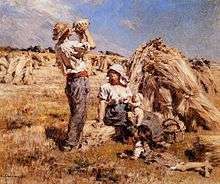Léon Augustin Lhermitte

Léon Augustin Lhermitte (31 July 1844, Mont-Saint-Père – 28 July 1925, Paris) was a French realist painter and etcher whose primary subject matter was of rural scenes depicting the peasant worker.
He was a student of Lecoq de Boisbaudran, he gained recognition after his show in the Paris Salon in 1864.
His many awards include the French Legion of Honour (1884) and the Grand Prize at the Exposition Universelle in 1889.
Lhermitte’s innovative use of pastels won him the admiration of his contemporaries. Vincent van Gogh wrote that "If every month Le Monde Illustré published one of his compositions ... it would be a great pleasure for me to be able to follow it. It is certain that for years I have not seen anything as beautiful as this scene by Lhermitte ... I am too preoccupied by Lhermitte this evening to be able to talk of other things."[1][2]
Lhermitte is represented in the collections of museums around the world, including Amsterdam, Boston, Brussels, Chicago, Florence, Montreal, Moscow, Paris, Rheims, and Washington.
Artwork
The Gleaners
Léon-Augustin Lhermitte's 1887 'The Gleaners". A part of the Realism movement and an avid realist painter, Lhermitte depicts the working class poverty in France. Taking very obvious inspiration from Millet, a painting of the same name, Lhermitte in a series of works displayed at the Salon aims to capture this moment in time. When comparing his work to Millet's, even the poses of the women are very similar if not the same. In the foreground there are two women bent over picking up the grains left behind, those that were not added into the hay stack which can be seen in the background. An obvious difference between this work and Millet's is that there is no large crowd of people working in the background. Similarly though the woman grasp the wheat in their hands but on the left side show a cache of what they have collected. This is vastly different that Millet's as his showed how little there was leftover. Lhermitte's shows quite a bit of excess. When viewing the ground, identifying individual wheat grains is difficult if not impossible. This could be a representation of how difficult the work is, the endless task of gathering enough wheat to keep the families of these women fed. Around the same time the painting by Lhermitte was published and presented on exhibit, Millet's own "The Gleaners" was beginning to receive public appreciation. This led Lhermitte to continue painting scenes of rural France, many of which share the same name, "The Gleaners". Looking closely at the individual gleaners, they have more "character" about each one. Rather than having plain smooth looking clothes like Millet's, Lhermitte opted for looser fitting shirts, as well as giving more detail to the faces of the women. The second woman reaching down has a pained expression on her face, like how reaching down all day tires a person. While a woman in Millet's painting shares the same trait, two others in Lhermitte's have different expression. The two women standing each have their bundle as seem like they are taking a small break, the woman farthest back has her hand on her back with an exacerbated look on her face. This piece leaves the viewer without a sense of closure, as if the day is just beginning and a hard day of work is still ahead.
References
- ↑ Léon Lhermitte 1844-1925, ex. cat., Beverley Hills: New York: Galerie Michael; Altman/Burke Fine Art, 1989, unpaginated
- ↑ Léon-Augustin Lhermitte - Fine Art Dealers Association
|
There is also a market scene painting by this painter in the Beaverbrook Art Gallery in Fredericton,New Brunswick.There is also a pastel work by this artist in the Boca Raton Art Museum in Florida.